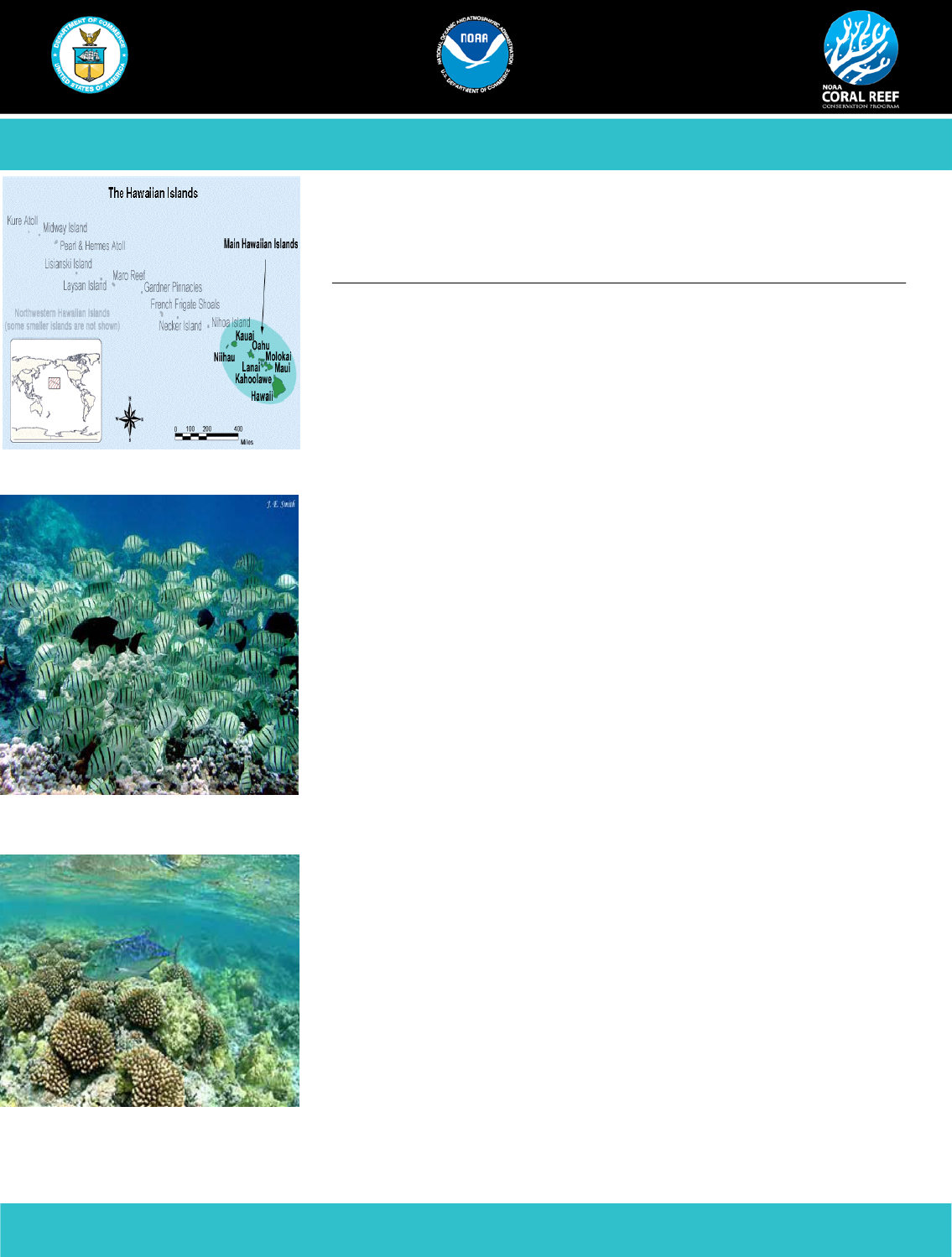
The Total Economic Value for Protecting and Restoring Hawaiian Coral Reef Ecosystems
Introduction
This is the second fact sheet
summarizing the results from a study
funded by NOAA’s Coral Reef
Conservation Program through the
National Ocean Service’s Office of
Response and Restoration and Office of
National Marine Sanctuaries. The study
was implemented through a contract with
Stratus Consulting, Inc.
What is included in “Total
Economic Value”?
For economists, the term “Total
Economic Value” or TEV includes the
net economic values generally referred
to as consumer’s surplus or the value
received by a consumer of a good or
service over and above what the
consumer is required to actually pay to
receive the good or service. So it is
referred to as a net value or surplus
value.
In our survey on Hawaii’s coral reef
ecosystem, TEV includes both some
direct use values (e.g. recreation-tourist
uses, seafood products, and products
harvested for the aquarium trade) and
passive use values (e.g. the willingness
to pay to leave a legacy by protecting the
coral reef ecosystem in a certain
condition for future generations
to
enjoy—bequest value or the
willingness
to pay to simply know that the coral reef
ecosystem will exist in a certain
protected condition—existence value).
What is not included in Total
Economic Value?
What is not included in TEV is the dollars
that people actually spend while undertaking
activities directly using the coral reef
ecosystems. So what is not included are
what economists call the economic impact on
the local, regional or national economy
usually stated in terms of expenditures and
associated sales/output, income and
employment in the economy. This would
include the dollars spent by either residents
or visitors of Hawaii recreating on the reefs.
The actual spending on seafood and
aquarium trade products harvested from the
coral reef ecosystems would not be counted
in TEV. Similarly, any amounts spent on
pharmaceutical items developed from things
harvested on the coral reefs or educational or
scientific projects directly using the coral reef
ecosystems would not be counted in TEV.
Although TEV should include other direct use
values (consumer’s surplus) such as any
pharmaceuticals being made from things
harvested from the coral reefs, education and
scientific activities related to coral reef
ecosystems, and storm or erosion protections
provided by reefs, our survey did not
specifically address these issues with survey
respondents, so they might not be included in
our estimates of TEV.
What are the appropriate uses of
“Total Economic Value”?
TEV can generally be used for the following:
a. Benefit-Cost Analyses of
investments to protect and/or
restore coral
reef ecosystems.
Main Hawaiian Islands
Schools of fish live near reefs
A variety of shallow coral
J.E. Smith
James Watt, Ocean Stock, Inc.
http://coralreef.noaa.gov/hicoraleconval/
Summary of Estimated Values

b. Damage Assessment Cases
where the State and/or Federal
governments sue responsible parties for
damages to the coral reef ecosystems.
The results can also be used specifically
for evaluating the benefits of protection &
restoration for all the coral reef ecosystems
around the Main Hawaiian Islands and for
localized injuries:
a. Resource protection &
restoration included management
strategies that would yield within 10 years
an increase in fish abundance and size
from 10% to 50% of historic values. This
would support increases in seals, sea birds
and other marine mammals and support
improving the health of the coral reef
ecosystems throughout the Main Hawaiian
Islands, improve the quality of recreation
and religious and cultural uses by native
Hawaiians.
b. Restoration of 5 acres per year of
coral reef ecosystems damaged by
ship/vessel groundings. The benefit of
restoration activity would be the full
recovery from damage in 10 years versus
50 years for natural recovery.
Annual Value Per Household
It was estimated that resource protection is
worth about $224.81 per year to the
average U.S. household, and repairing 5
acres of reef per year is worth about
$62.82 per year for a total value per
household of $287.62 (Table 1).
Annual Value All U.S Households
The 2010 U.S. Census estimates there
were 116,716,292 households in the U.S.
Multiplying the average values per
household times the number of households
yields an estimate of $26.24 billion per
year for resource protection and $7.33
billion per year for reef restoration for a
total value per year of $33.57 billion
(Table 2).
To access other facts sheets, executive
summary or the full report go to
http://coralreef.noaa.gov/hicoraleconval/
or
contact
Bob Leeworthy, Chief Economist
Office of National Marine Sanctuaries
NOAA, National Ocean Service
1305 East West Highway, SSMC4, 11
th
fl
Silver Spring, MD 20910
Telephone: (301) 713-7261
Fax: (301) 713-0404
E-mail: Bob.Leeworthy@noaa.gov
or
Jon Corsiglia, Communications & Outreach
Specialist
NOAA Coral Reef Conservation Program
1305 East West Highway, SSMC4, 10
th
fl
Silver spring, MD 20910
Telephone: (301) 713-3155 ext. 167
E-mail: jon.corsiglia@noaa.gov
Sea urchins are common in Hawaii
John Davies
Table 1. Mean Willingness to Pay (WTP) N=3,183
Value of
Estimated
WTP
Standard
Error
95%
confidence
interval
Ecosystem-wide Protection
& Restoration
$224.81
$32.19
$161.72 to
$287.89
Restoration after Localized
Injuries
$62.82
$21.73
$20.23 to
$105.40
Total
$287.62
$48.04
$193.46 to
$381.78
Table 2. Estimated Annual Willingness to Pay
Value of
Estimated
WTP
(Billions $)
95% confidence
interval
(Billions $)
Ecosystem-wide Protection &
Restoration
$26.24
$18.88 to $33.60
Restoration after Localized
Injuries
$7.33
$2.36 to $12.30
Total
$33.57
$22.58 to $44.56
http://coralreef.noaa.gov/hicoraleconval/
